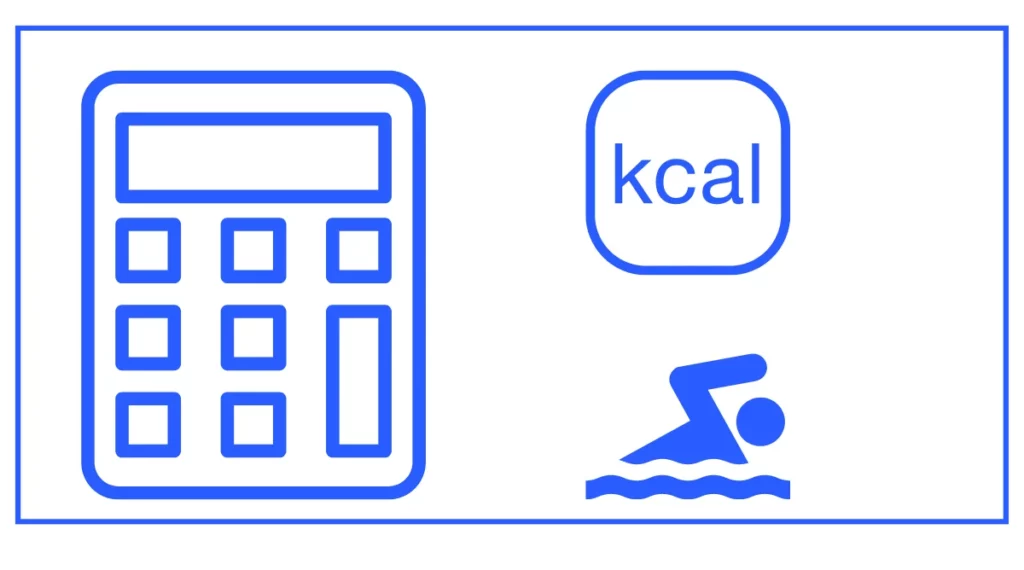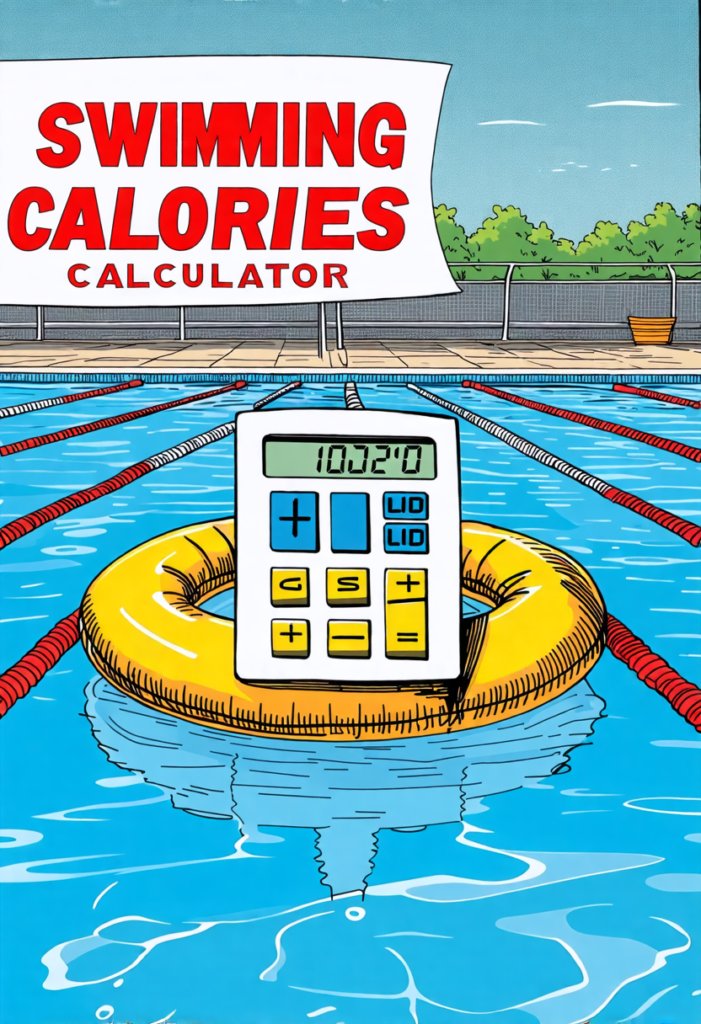Swimming Calories Calculator
You’re burning: 0 kcal/min
You will burn: 0 kcal
Do you want to discover how many calories you burnt by swimming 🏊?
This swimming calories calculator helps you find the number of calories you burnt in your last session or will be burning t your next swimming session.
You only have to choose your swimming style ( Butterfly, backstroke, breaststroke, crawl, sidestroke, aqua jogging, treading water, or water walking) and enter your body weight and swimming time.

You can also find the number of calories burnt by Climbing Stairs or by Walking.
How to Use the Swimming Calorie Calculator?
Using our swimming calorie calculator is straightforward and user-friendly. Follow these simple steps to estimate your calorie burn:
- Select your swimming style from the dropdown menu.
- Enter your body weight in kilograms.
- Input the duration of your swim in minutes.
- Click the “Calculate” button to see your results.
The calculator will then display two key pieces of information:
- The number of calories you burn per minute
- The total number of calories burned during your swimming session
Understanding Calorie Burn in Swimming
Calorie burn during swimming varies based on several factors. Let’s explore the key elements that influence how many calories you burn while swimming:
Swimming Intensity and Strokes
Different swimming strokes and intensities result in varying levels of calorie burn. Generally, more vigorous strokes like butterfly and intense freestyle burn more calories compared to relaxed strokes like leisurely backstroke. Here’s a brief overview of common swimming strokes and their relative calorie-burning potential:
- Butterfly: This stroke is often considered the most calorie-intensive, burning approximately 13.8 calories per minute for a 70 kg person.
- Breaststroke: Intense breaststroke can burn about 10.3 calories per minute, while a recreational pace burns around 5.3 calories per minute.
- Freestyle (Crawl): Vigorous freestyle swimming burns about 10 calories per minute, with a more relaxed pace burning around 8.3 calories per minute.
- Backstroke: Intense backstroke burns approximately 9.5 calories per minute, while a leisurely pace burns about 4.8 calories per minute.
- Treading Water: Even treading water can be a good calorie-burner, with high-effort treading burning about 9.8 calories per minute and relaxed treading burning 3.5 calories per minute.
Body Weight
Your body weight plays a significant role in determining calorie burn. Generally, a person with a higher body weight will burn more calories performing the same activity as someone with a lower body weight. This is because it takes more energy to move a larger mass through the water.
Duration
The length of your swimming session directly impacts the total number of calories burned. Longer swims naturally result in a higher calorie expenditure. For example, a 30-minute swim will burn twice as many calories as a 15-minute swim, assuming the same intensity and body weight.
The Science Behind the Calculator
Our swimming calorie calculator uses the concept of Metabolic Equivalent of Task (MET) to estimate calorie burn. MET is a measure of the energy cost of physical activities. One MET is defined as the amount of oxygen consumed while sitting quietly, which is approximately 3.5 ml of oxygen per kilogram of body weight per minute.
The calculator uses the following formula to estimate calorie burn:
Calories Burned = (MET x 3.5 x Weight in kg x Duration in minutes) / 200
Each swimming style has a specific MET value based on its intensity. For example:
- Butterfly stroke: 13.8 MET
- Vigorous freestyle: 10 MET
- Leisurely backstroke: 4.8 MET
By inputting your chosen swimming style, weight, and duration, the calculator can provide an estimate of your calorie burn.
Benefits of Swimming for Calorie Burn and Overall Health
Swimming is not only an effective calorie-burner but also offers numerous health benefits:
- Low-Impact Exercise: Swimming is gentle on the joints, making it an excellent option for people with joint issues or those recovering from injuries.
- Full-Body Workout: Swimming engages multiple muscle groups simultaneously, providing a comprehensive workout for your entire body.
- Cardiovascular Health: Regular swimming can improve heart health, lower blood pressure, and enhance lung capacity.
- Flexibility: The range of motion required in swimming can help improve overall flexibility and reduce the risk of injury in daily activities.
- Stress Relief: Many people find swimming to be a relaxing and meditative activity, helping to reduce stress and improve mental well-being.
Tips to Maximize Calorie Burn While Swimming
If you’re looking to increase your calorie burn during swimming sessions, consider these strategies:
- Vary Your Strokes: Incorporate more vigorous strokes like butterfly or intense freestyle into your routine.
- Increase Intensity: Try interval training by alternating between periods of high-intensity swimming and recovery periods.
- Extend Duration: Gradually increase the length of your swimming sessions to burn more calories overall.
- Use Resistance Tools: Incorporate swimming aids like pull buoys or paddles to increase resistance and calorie burn.
- Practice Proper Form: Efficient swimming technique not only improves your performance but also helps you maintain a higher intensity for longer periods.
Comparing Swimming to Other Forms of Exercise
Swimming is a highly effective calorie-burning activity, often comparable to or exceeding other popular forms of exercise. Here’s how swimming stacks up against some other common activities in terms of calorie burn (estimates for a 70 kg person):
- Vigorous freestyle swimming: 700 calories per hour
- Running at 8 km/h: 606 calories per hour
- Cycling at 20 km/h: 563 calories per hour
- Brisk walking at 6.5 km/h: 352 calories per hour
Remember that these are general estimates, and actual calorie burn can vary based on individual factors and exercise intensity.
Incorporating Swimming into Your Fitness Routine
To make the most of swimming for calorie burn and overall fitness, consider these tips:
- Set Goals: Establish clear, achievable goals for your swimming routine, such as increasing your lap count or improving your time.
- Create a Schedule: Plan regular swimming sessions to maintain consistency in your workout routine.
- Track Progress: Use our swimming calorie calculator to monitor your calorie burn over time and adjust your workouts accordingly.
- Mix It Up: Incorporate different strokes and swimming workouts to prevent boredom and challenge different muscle groups.
- Stay Hydrated: Even though you’re in water, it’s important to drink plenty of fluids before, during, and after your swim.
- Listen to Your Body: Pay attention to how you feel during and after swimming, and adjust your intensity or duration as needed.






